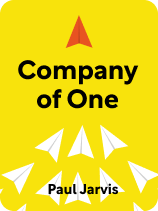
Do you have a great business idea? Are you overwhelmed or even intimidated by the thought of growing a large business?
Fear not. According to Paul Jarvis’s Company of One, you can start a business by yourself and keep it that way—a company of one. In his book, Jarvis explores the pitfalls of companies that grow fast and large, presents the benefits of single-person companies, and outlines how to start one.
Continue reading for an overview of this book that just might be the entrepreneurial green light you’ve been looking for.
Overview of Paul Jarvis’s Company of One
Perhaps you’ve wished that you could own a company, but you feel out of place in the fast-paced, growth-focused world of business. You can find the solution in Paul Jarvis’s Company of One (2019). Jarvis extols the advantages of a single-person company that limits its growth and focuses on creating quality products and services. He argues that, by owning such a company, you can exercise more control over your work, create your own schedule, and form meaningful, successful relationships with customers.
For years, Jarvis worked as a corporate web designer for companies such as Microsoft and Mercedes-Benz and clients such as Shaquille O’Neal and Steve Nash. Then, he pivoted to helping entrepreneurs construct their online brands. Today, he runs a company called Mighty Small Ventures, through which he teaches classes, creates software, and writes. His ideas have also been published on websites such as VICE News, WIRED, and USA Today.
We’ll explore why fast and endless growth isn’t always the best goal for a business and define the most important characteristics of a “company of one”—which we’ll refer to as a single-person company. Additionally, we’ll discuss some of Jarvis’s tips for starting a single-person company.
Why Growth-Focused Companies Don’t Always Work
To begin, let’s examine three reasons behind Jarvis’s argument that constant growth doesn’t have to be a company’s primary goal—despite this being a common ethos in the business world.
Reason #1: Growth Increases Complications
According to Jarvis, growth brings inevitable complications for a business. When traditional companies grow and scale, they have to spend more money and hire more employees. This requires a more robust infrastructure, so these companies must invest in new systems that further complicate and slow down work processes.
For example, video game company Zynga spent $100 million on building their own data centers after achieving success with their free game downloads. This became a financial burden for the company as they struggled to keep up with innovations in the video game industry, eventually forcing them to lay off a large number of employees and close the data centers.
If you’re the owner of a company that’s constantly growing, you’ll likely spend more time managing the increasingly complex infrastructure than on the core work—creating or designing a product or service. That core work is the reason you wanted to start the business—a reason that’s unrelated to money. So managing growth takes you away from your original purpose.
Example: Losing Sight of the Core Work
Let’s look at an example of how managing a large company might prevent you from focusing on the core work. Say you run a business that offers book therapy: curated selections of books based on the users’ current mental health needs. Initially, you personally read each user’s profile and create their book selection. This is the core work, and it serves your original purpose for starting the business: to improve people’s lives using the psychological and emotional benefits of reading.
However, as the business grows, you have to hire employees to take on some of this work, and now you spend more time managing them along with the greater vision and day-to-day operations of the company. You spend less time selecting books and communicating with customers. As interest in your service keeps increasing, you develop an algorithm that automatically creates book selections based on customer needs, eliminating personalized, human involvement. Eventually, you spend all your time on tasks that are unrelated to the core work of book curation and the original purpose of helping people. Instead, you’re primarily focused on keeping the company going and increasing profits every year.
Reason #2: Fast Growth Often Leads to Quick Failure
Jarvis argues that, in addition to experiencing the complications of all large companies, companies that attempt to grow substantially in a short time (such as startups) often fail. This is because they spend money they don’t have to facilitate growth. Owners are motivated by the traditional business ethos that success means scaling up and making as much money as possible. So, they spend based on projected revenue instead of their actual revenue, thinking that they’ll recoup it soon enough to keep spending and growing.
When a company spends money based on projections instead of current revenue, it’s a gamble. If their upfront spending pays off, then they have a large, successful company that they can continue to expand or sell. However, if their revenue projections don’t match the actual revenue (which is statistically the more likely scenario), they’re unable to recoup what they spent, and the company collapses. When a high-growth company fails, huge layoffs usually follow, and the company often sells for well below its market value.
For example, Australian startup Shoes of Prey tried to scale by expanding beyond its original model as a web-based custom shoe design service by opening physical stores in malls across the world. With an influx of venture capital funds, the owners spent huge amounts of money, moved to the United States, and hired a lot of new staff to get the project going. However, their sales from the physical stores didn’t match projections, so the company couldn’t generate a return on its investments. This resulted in massive layoffs and its collapse in 2018.
Reason #3: Fast Growth May Harm Your Original Customers
Finally, Jarvis states that fast growth often leads you to make compromises that can harm your relationships with your original customers. Rapid growth typically requires outside investors, which means you have to answer to people beyond yourself and your customers. Investors want returns on their investments, so they bring their own opinions and agendas to the company, some of which may not align with its original mission and goals. If you have investors who don’t support your company’s purpose, you may have to make changes that please them but also alienate your core customer base.
For example, say your company offers prerecorded online cooking classes. From the beginning, you’ve been dedicated to keeping the videos ad-free, and many customers choose your classes because of this feature. However, you bring on some investors who want the company to grow quickly, so they push you to include ads that bring in more revenue. You finally give in, which pleases your investors. It also damages your relationship with your customers since you went back on your original promise, leading to losses in subscribers.
The Three Main Characteristics of a Single-Person Company
Jarvis discusses the reasons not to push your company toward fast, unsustainable growth, and he presents an alternative path. According to Jarvis, a single-person company focuses on simplicity and stability. As the owner of a single-person company, your primary goal is to make enough revenue to pay yourself a salary and cover your business expenses.
Over time, you may slowly grow your company’s profit as the quality of your products and services draws in more customers. However, you consciously limit this growth by limiting the number of clients or customers you take on and limiting your revenue goals. Running the company yourself remains manageable.
Jarvis describes three primary characteristics that define a single-person company and its owner:
Characteristic #1: De-Emphasis on Growth
Jarvis states that a core aspect of a single-person company is its de-emphasis on growth. Instead of solving problems by spending more money and acquiring more resources as traditional growth-focused companies do, single-person companies find solutions using their existing resources.
For example, a growth-focused company might solve the problem of how to attract more customers by increasing the money it spends on advertising. Additionally, it might hire more marketing employees to create strategies for customer acquisition, with the ultimate goal being to increase the size and profits of the company.
In contrast, the owner of a single-person company wouldn’t spend more money or hire more employees to expand its customer base—they would instead focus on creating a high-quality service or product. The better a service or product is, the more likely it is that customers will recommend it to their friends. Over time, the company’s network of clients and customers increases through word of mouth.
Characteristic #2: Adaptability to Changing Circumstances
Jarvis says single-person companies can adapt to changing circumstances and endure hardship. One challenge may be market changes caused by world events or new technologies. With an adaptive, resilient mindset, owners of single-person companies can pivot more easily when they encounter such challenges than larger companies can.
Single-person companies are adaptable to hardship and changing circumstances because they typically have a strong purpose, not just the desire to make money. This purpose stems from your values as the owner—the reasons you do the work apart from profit. For example, your company’s purpose might be to support social and economic justice, help people advance their careers, or promote sustainability.
Characteristic #3: Increased Independence and Control
According to Jarvis, owning a single-person company also gives you more independence than you’d have as the owner of a fast-growing company or an employee at someone else’s company. Because your business stays intentionally small (meaning you’re likely the only one working there) and uses existing resources to solve problems, you have complete creative, financial, and administrative control. Therefore, you get to decide how often you work, when you work, who you work with, and so on.
For example, say you’re a graphic designer. If you’re working at a firm, management determines your projects and clients. You have to prioritize your work based on what other people want from you. However, if you own your own graphic design company, you can choose your clients and decide how many projects to take on at any given time.
Getting Started With Your Single-Person Company
Let’s dive into three pieces of practical advice for starting your single-person company:
- How to build your skill set so you’re prepared to run your own business
- How to set up a strong financial and legal foundation
- How to develop strong customer relationships
Tip #1: Build Your Skill Set
Jarvis suggests building your skill set before starting your single-person company. To be successfully independent, you have to be good enough to stand on your own. You can achieve this in a variety of ways, including working for a while at an existing company to gain experience, taking classes, or practicing skills on your own.
First, hone your knowledge and skill in the work that forms the core of what you want your single-person company to be. For example, consider the example of the business that offers online cooking classes—before you open such a company, you should learn from other chefs, practice your teaching skills as an instructor at an existing cooking school, and so on. This will give you credibility as an expert in your field and ensure that you can offer a quality product or service.
Second, acquire a broad understanding of administrative and practical business skills. As the owner of a single-person company, you’re responsible for every aspect of the business, so you need to have a working knowledge of many types of work outside of your core work. These include marketing, accounting, payroll, sales, project management, and more.
Tip #2: Set Up a Strong Legal Foundation
According to Jarvis, getting the legal systems of your business in order from the start ensures you don’t get duped out of any money you’re owed or get into trouble for operating illegally. We’ve organized Jarvis’s recommendations for protecting yourself legally into three steps:
Step #1: Set up your company as a legal entity separate from yourself. This would be an LLC in the United States. Your business makes money from your work, instead of you making it directly. You then pay yourself a salary from the business. This ensures that you aren’t personally liable if anything goes awry in your business. Rather, the business itself is liable.
Step #2: Create terms of service if you sell products, and create contracts if you offer a service. Customers have to agree to terms of service before buying your products. Likewise, clients have to sign a contract before you begin working with them. This creates transparency and offers protection for you, preventing customers and clients from neglecting to pay you or taking advantage of you in another way.
Step #3: Contract a business lawyer to help you with the legal aspects of your company. An experienced lawyer will make sure that:
- Your contracts or terms of service are sound
- Your company is operating within the legal boundaries of your particular business and location
- You don’t make mistakes that lead to expensive lawsuits
Tip #3: Develop Strong Customer Relationships
Finally, Jarvis argues that it’s vital for a single-person company to foster strong connections with its customers. Since these companies aren’t receiving money from investors, they depend on customer relationships to sustain and grow their business. Here are two of Jarvis’s suggestions for having beneficial customer interactions:
Suggestion #1: Be an Educator
When you’re looking for prospective customers, Jarvis suggests playing the role of educator as a sales strategy. Teach people about your product or service, including how to use it so it best serves them.
Being an educator requires transparency, clearly demonstrating the strengths of your product or service. When you can show your product’s unique strengths, you’ll stand out against competitors.
Additionally, by acting as an educator for your product or service, you show customers that you’re the expert in your field, which builds trust. You’re the first person who comes to mind when they need whatever type of product or service you’re offering, and they’re more likely to buy from you.
To teach about your product or service, you might use social media, teach classes that show people how it works, and so on. For example, Toni Okamoto, founder of the website Plant-Based on a Budget, teaches people how to eat a healthy and affordable plant-based diet. Her website has hundreds of free recipes, she posts regularly about plant-based cooking on social media, she speaks about it on podcasts, and she offers a newsletter with recipes and tips.
Anyone can use these resources to learn about her methods and ideas. However, they also act as a sales pitch for her business, through which she sells meal plans and cookbooks and participates in speaking engagements. By giving her knowledge away freely and showing customers how they can be successful with her services, she builds trust and expertise. If people like her content, the free education entices them to invest in her brand further by purchasing her products.
Suggestion #2: Prioritize Quality Over Quantity
Jarvis argues that a single-person company should prioritize creating high-quality, long-term relationships with customers, rather than concentrating on acquiring a greater quantity of customers. This means focusing on providing the best quality service and products possible for each person you serve.
Jarvis argues that focusing on serving existing customers will help you maintain consistent revenue as loyal customers keep coming back. Owning a single-person company allows you to maintain strong, personal, and long-lasting relationships with customers because its small size means you have the time and capacity to focus on each individual’s needs.
Additionally, loyal customers become a cost-free part of your marketing strategy—if they’re satisfied with your services or products, they’ll likely recommend your company to their friends and family, which generates new business, money, and slow, sustainable growth.

———End of Preview———
Like what you just read? Read the rest of the world's best book summary and analysis of Paul Jarvis's "Company of One" at Shortform.
Here's what you'll find in our full Company of One summary:
- Why growth-focused companies don't always work
- Why single-person companies often excel in quality and service
- Tips on how to get started with your own single-person company






